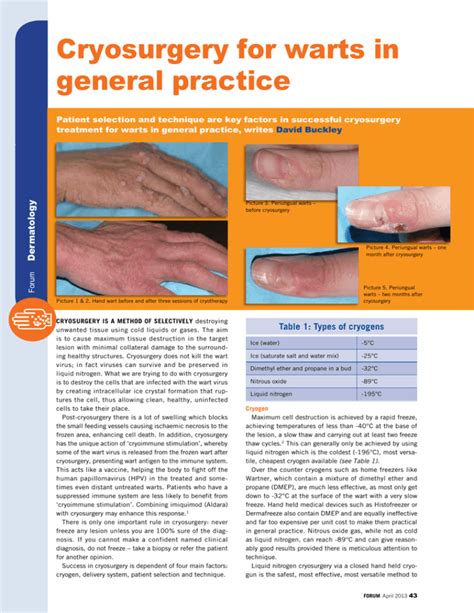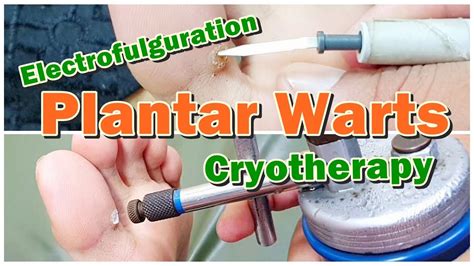Cryotherapy, also known as cryosurgery, is a medical treatment that utilizes extremely low temperatures to destroy abnormal or damaged cells. It has been widely used to treat various conditions, including warts. Warts are small, rough growths on the skin caused by the human papillomavirus (HPV), and they can appear on any part of the body. In this article, we will delve into the world of cryotherapy and its application in treating warts, exploring the benefits, risks, and what to expect during the treatment process.
Understanding Warts

Before we dive into the details of cryotherapy, it’s essential to understand what warts are and how they develop. Warts are contagious and can spread through skin-to-skin contact or by touching contaminated surfaces. They are more common in children and young adults, but anyone can develop warts. There are several types of warts, including common warts, plantar warts, flat warts, and genital warts, each with distinct characteristics and locations on the body.
What is Cryotherapy?

Cryotherapy is a non-invasive procedure that uses liquid nitrogen to freeze and destroy abnormal cells. The extremely low temperature of liquid nitrogen, typically around -196°C, causes the water inside the cells to form ice crystals, leading to cell death. This process is known as cryonecrosis. Cryotherapy is not only used for treating warts but also for other skin conditions like actinic keratosis, seborrheic keratosis, and certain types of skin cancers.
The Cryotherapy Process for Warts
The process of cryotherapy for warts is relatively straightforward and can be performed in a doctor’s office. Here’s what you can expect:
- Preparation: The area around the wart is cleansed with an antiseptic solution to prevent infection.
- Application of Liquid Nitrogen: The doctor uses a cotton swab or a spray device to apply liquid nitrogen directly to the wart. The freezing process usually takes about 10 to 30 seconds, depending on the size and location of the wart.
- Reaction: After the application, a blister may form within 24 hours, and it may take up to 4 weeks for the area to fully heal. During this time, the wart will eventually fall off.
Benefits of Cryotherapy for Warts
Cryotherapy offers several benefits when it comes to treating warts, including:
- High Success Rate: Cryotherapy has a high success rate, especially for smaller warts.
- Minimally Invasive: The procedure is non-invasive, meaning it does not require surgery or stitches.
- Low Risk of Scarring: When performed correctly, cryotherapy has a low risk of scarring.
- Quick Procedure: The treatment itself is very quick, usually taking only a few minutes.
Risks and Side Effects

While cryotherapy is generally safe, there are potential risks and side effects to consider:
- Pain: The freezing process can be painful, and some discomfort may persist after the procedure.
- Blisters and Scabbing: A blister or scab may form over the treated area, which can be unsightly and may take several weeks to heal.
- Infection: As with any skin treatment, there is a small risk of infection.
- Nerve Damage: Rarely, cryotherapy can cause temporary or, very rarely, permanent nerve damage, leading to numbness or tingling sensations in the treated area.
Alternatives to Cryotherapy
Not everyone may be a candidate for cryotherapy, or they may prefer to explore other treatment options. Some alternatives include:
- Salicylic Acid Treatments: Over-the-counter or prescription medications that help dissolve the keratin protein that makes up the wart.
- Cantharidin: A blistering agent that is applied to the wart, causing it to eventually fall off.
- Immunotherapy: Treatments that stimulate the body’s immune system to fight off the virus causing the warts.
- Surgical Removal: In some cases, surgical removal of the wart may be necessary, especially for larger or more persistent warts.
Preventing Warts
While treating warts is important, preventing them from occurring in the first place is even better. Here are some tips to reduce the risk of getting warts:
- Wash Your Hands Regularly: Especially after touching someone who has warts or after being in contact with potentially contaminated surfaces.
- Keep Your Skin Healthy: Dry, cracked skin is more susceptible to wart viruses. Keeping your skin moisturized can help prevent warts.
- Avoid Walking Barefoot: In public areas like pools and locker rooms, as this can increase the risk of getting plantar warts.
- Avoid Sharing Personal Items: Items like towels, razors, and makeup can spread the virus.
FAQ Section
How effective is cryotherapy for treating warts?
+Cryotherapy is highly effective for treating warts, with success rates ranging from 70% to over 90% for certain types of warts. However, the effectiveness can depend on the size, location, and type of wart, as well as the individual's overall health and the expertise of the practitioner performing the treatment.
Does cryotherapy hurt?
+The application of liquid nitrogen during cryotherapy can be somewhat painful and may cause a stinging or burning sensation. This discomfort is usually temporary and can be managed with over-the-counter pain relievers. However, for some people, the pain can be more significant, especially if the wart is in a sensitive area.
How long does it take to recover from cryotherapy for warts?
+The recovery time after cryotherapy for warts can vary depending on the size and location of the wart, as well as the individual's healing process. Generally, it can take up to 4 weeks for the area to fully heal. During this time, a blister may form, and the wart will eventually fall off. It's essential to keep the area clean and follow any post-treatment instructions provided by your healthcare professional to ensure proper healing and minimize the risk of complications.
Conclusion
Cryotherapy is a viable and effective treatment option for warts, offering a high success rate with minimal invasion and low risk of scarring. However, it’s crucial to understand the potential risks and side effects, such as pain, blisters, and the small risk of infection or nerve damage. By discussing your specific situation with a healthcare professional, you can determine if cryotherapy is the right choice for you. Remember, prevention is key, and taking steps to avoid getting warts in the first place can save you from the hassle and discomfort of treatment. With the right approach and care, it’s possible to effectively treat warts and enjoy healthier, clearer skin.



